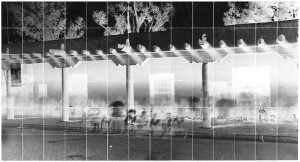Our last From the Collection post featured a saddle made by Austin Slim Green (1916-2008.) You can hear from the master in his own words in this Bluehighwaystv video posted in 2012.
From the Collection
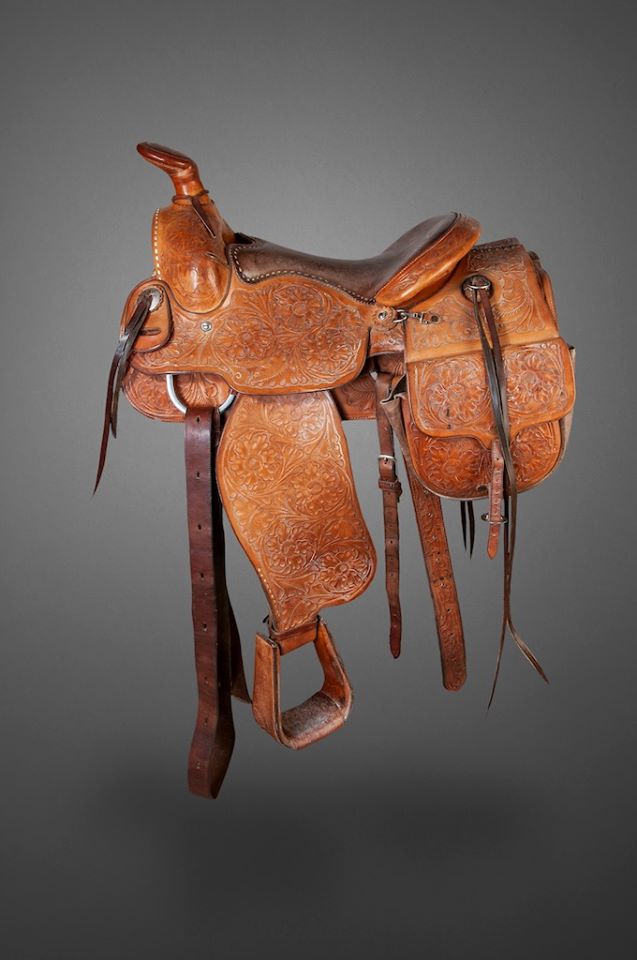
Did you know?
The New Mexico History Museum has seventy saddles in our collection that range from the 17th through the 20th century. Some of them were pack saddles meant to carry heavy loads, while some of them were made for show. We have saddles made in the colonial Mexican tradition, some made by Native people, and some created by well-known saddle makers, such as this one by Austin “Slim” Green (1916-2008).
This hand-tooled leather stock saddle was made in the 1970s for John Egan of the Rancho Encantado (previously Rancho del Monte) area near Santa Fe.
Originally from Oklahoma, Slim Green moved to northern New Mexico following World War II and further refined his talents working with leather. Slim Green was a co-founder of the Rodeo de Santa Fe, taught Tesuque elementary kids leather craft, and produced custom-made saddles for people all over the country. We’re lucky to have one of his saddles!
You can see more of Slim Green’s work at the New Mexico Farm & Ranch Heritage Museum in Las Cruces, where his workshop and tools permanently reside.
Check out this 2012 post on Slim Green and our beloved Cowboys exhibition.
Making History: In a New Mexico Garden
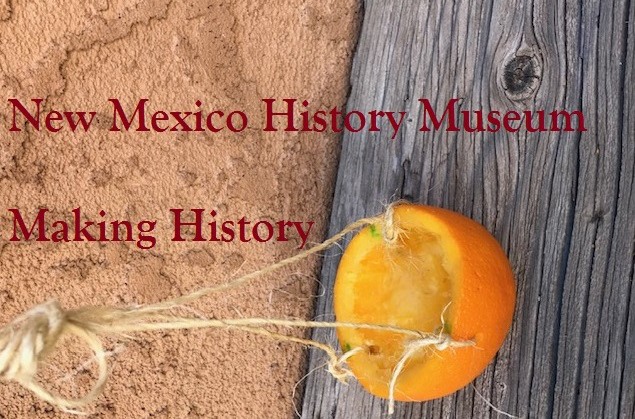
Making History is the New Mexico History Museum’s monthly series of hands-on activities that further illuminates the Museum’s collections as well as New Mexico’s heritage of historic technologies and crafts. The Making History Program is family friendly and open to everyone.
With the Museum being closed due to the COVID-19 mitigation efforts, this month’s Making History Program has gone online in two parts.
Join museum Educator Melanie LaBorwit as she demonstrates how to make pots for your seedlings using a newspaper in Part 1, and in Part 2, Melanie will show you how to give nourishment to your feathered neighbors by making a bird feeder from an orange and some twine.
Enjoy these activites to enhance your garden and check back next month for a new making opportunity.
From the Collection
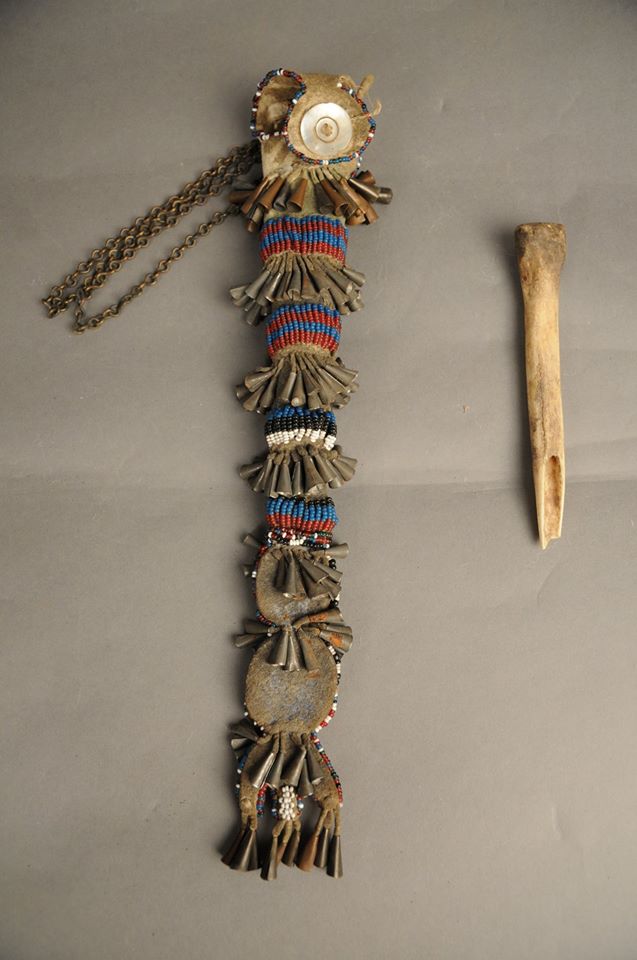
This Mescalero Apache beaded hide awl case, ca. 1880, was used to store the bone awl. The awl was used as a tool to weave basketry, and or sew glass trade beads on hide. It was owned by the Southwest photographer, Ben Wittick, who used objects such as this one, as props in his studio where he photographed Native Americans in the late 19th century. Visit this artifact at the New Mexico History Museum’s exhibition Looking Back, when it reopens to the public and in the meantime, stay safe.
From the Collection
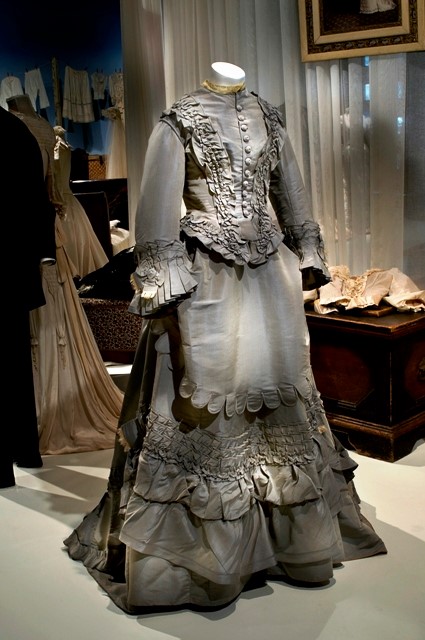
What are you wearing these days?
With social distancing in progress, most of us are working from home in our sweatpants or other athleisure wear. Take a look at what a Victorian lady may have worn when at home during the day. This 1870s dress has a taffeta bodice and skirt ensemble lined with crinoline underneath to give it fullness. This dress is typical of the period with layers of ruffles, pleats and gathers.
History Collections NMHM 928.45
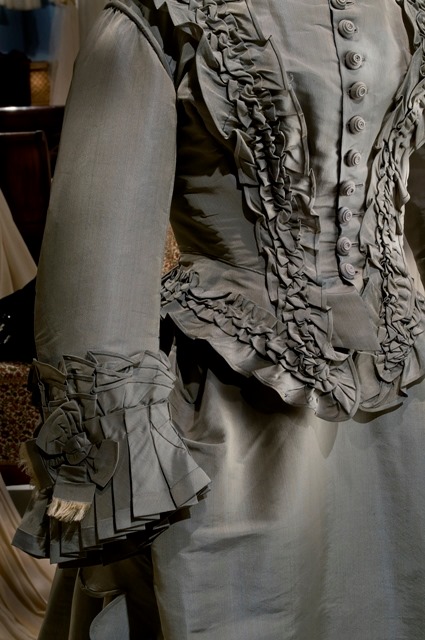
A Grand Dame of the Printing Arts
Joining our friends group, the Palace Guard, carries perks. Among them: a series of field trips, including a September visit to an unknown gem of Santa Fe.
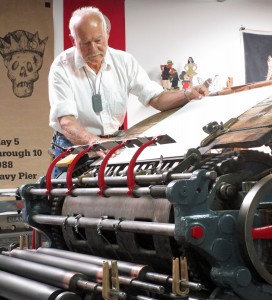 Jack Lemon (at left) founded Landfall Press in Chicago in 1970. Eleven years ago, he moved the operation here, carrying a legacy of working with international artists and fine stone lithography.
Jack Lemon (at left) founded Landfall Press in Chicago in 1970. Eleven years ago, he moved the operation here, carrying a legacy of working with international artists and fine stone lithography.
To better understand the role that lithographic images played in forming people’s opinions of the Civil War, Palace Press Director Tom Leech arranged a special tour and a demonstration on Landfall’s mammoth Marinoni Voirin press. (See a cool video here.)
With Meredith Davidson and Daniel Kosharek, Leech co-curated our exhibit, Fading Memories: Echoes of the Civil War. His portion explores how mass distribution of lithographic images shaped the opinions of a largely illiterate public. Pointing to Landfall’s precious stone bearing an image of Frederick Douglass, Leech noted that it was made by Louis Kurz of the Kurz and Allison publishing team.
“In our exhibit, The Fort Pillow Massacre is one outstanding example of their work,” he said. “These prints were sold to survivors and families as memorial pieces that glorified the war. Somewhere along the line, Kurz’s conscience got to him, and he included black soldiers in a way that was very honorable.”
Seeing the Palace Through a Pinhole
During the 2012 Worldwide Pinhole Photography Day, Heather Oelklaus, a photographer and print workshop supervisor at Colorado College, was talking with some friends about the wonders of capturing the world the old-fashioned way. One of them asked her about the largest pinhole camera she’d ever used. At that point, it was an aluminum trash can that required two pieces of 16×20” photo paper for film. But the question made her want to go even bigger.
“I proclaimed that by next year’s pinhole day, I would be shooting with a truck,” she said.
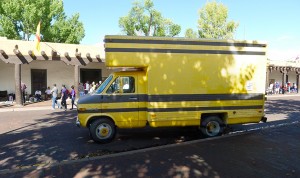 It took some scouting around before she found a 14-foot 1977 Chevy box truck with an uncanny resemblance to a yellow Kodak film box. She tackled drilling, painting, designing and light-tighting it while her imagination reeled out possible photo opps. In 2013, the newly designed pinhole truck, dubbed Little Miss Sunshine, took to the open road, shooting enough images to stage a show this year at the Sangre de Cristo Arts Center in Pueblo, Colo.
It took some scouting around before she found a 14-foot 1977 Chevy box truck with an uncanny resemblance to a yellow Kodak film box. She tackled drilling, painting, designing and light-tighting it while her imagination reeled out possible photo opps. In 2013, the newly designed pinhole truck, dubbed Little Miss Sunshine, took to the open road, shooting enough images to stage a show this year at the Sangre de Cristo Arts Center in Pueblo, Colo.
By then, Oelklaus (learn more about her by clicking here) had fallen in love with our exhibit, Poetics of Light: Pinhole Photography. “When I saw it the first time, I wept,” she said. “It sounds melodramatic, but to know there were people and a museum that understood what I loved about pinhole photography overwhelmed me.”
Photo Curator Daniel Kosharek and Palace Press Curator Tom Leech found out about her big truck and hatched a plot to shoot our beloved Palace of the Governors.
 This fall, Oelklaus arrived on a beautiful morning and recruited nine people to place 84 pieces of black-and-white darkroom paper on the truck’s walls, using tiny magnets. The Palace was exposed for 60 minutes, then the sheets were taken into a darkroom to develop.
This fall, Oelklaus arrived on a beautiful morning and recruited nine people to place 84 pieces of black-and-white darkroom paper on the truck’s walls, using tiny magnets. The Palace was exposed for 60 minutes, then the sheets were taken into a darkroom to develop.
“As the prints were coming out of the darkroom, many of the participants enjoyed putting the large-scale puzzle together so we could see the fruit of our labor,” she said.
We’re now looking for the perfect place to display the 5×20’ image, a grand celebration of pinhole artistry.
“The outside world squeezing through this tiny aperture and being projected on the inside of my camera truck inspires me,” Oelklaus said. “Recording the world differently and over long periods of time is a main theme for my recent work.”
Money, money, money
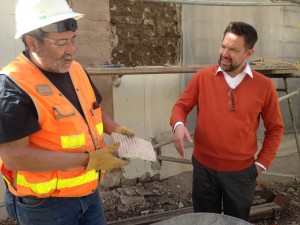 Do you ever wonder how the History Museum pays for all the wonderful exhibits we have? Or its knowledgeable staff? Or that fabulous lecture? The answer is … well, it’s complicated.
Do you ever wonder how the History Museum pays for all the wonderful exhibits we have? Or its knowledgeable staff? Or that fabulous lecture? The answer is … well, it’s complicated.
Under this year’s budget, the state of New Mexico provided about $2.8 million for operating costs, including salaries, utilities, and supplies. Last year’s Legislature provided an additional $680,000 for capital improvements, which includes the ongoing Palace renovation. (That’s museum Director Andrew Wulf on the right, talking with Elmo Griego of Longhorn Construction, which is overseeing the Palace stucco project.)
The Museum of New Mexico Foundation will raise another $550,000 or so this year for exhibits and programs—although that sum is a moving target, given two new major exhibits opening in May. The museum also enjoys generous support from Los Compadres, who members have repeatedly stepped up to raise money for all manner of special projects. Foundation and museum staff also collaborates to apply for grants that produce even more money, usually for public programs like lectures and symposia.
Wanted: Great Ideas for Family Programs
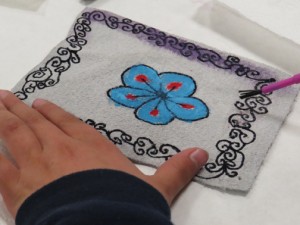 What are some of your favorite memories of visiting museums when you were a child? What do your own children remember from your family’s trips? What makes families want to come back to a museum? How can we be more family friendly?
What are some of your favorite memories of visiting museums when you were a child? What do your own children remember from your family’s trips? What makes families want to come back to a museum? How can we be more family friendly?
Those are some of the questions we’ve been asking ourselves lately. Now we want you to join the conversation.
Growing out of a chat between Director Andrew Wulf and Educator Melanie LaBorwit about the kinds of cultural activities each of them enjoy with their children, we recently launched a new committee. We wanted experts on family fun, so turned first to staffers who just so happen to be parents. With them, we’re sharing individual experiences with children in museums.
LaBorwit leads the monthly meetings, seeking ideas and ways to flesh out new family initiatives. Among our goals is developing new interactive spaces where people of all ages can learn together and creatively enjoy the museum.
Look for a launch of our summer camp, Time Trekkers, coming up soon with hands-on projects and fun activities. Registration will open this spring. Also, join us every third Sunday of every month for free, hands-on Families Make History workshops.
For more information or to share your ideas for family programs, contact LaBorwit at Melanie.Laborwit@state.nm.us or 505-476-5044.
Early Childhood Education Thrives at the Museum
 In just over two years, the New Mexico History Museum’s pre-K program for local Head Start classrooms provided more than 1,500 free visits and classroom time to children, parents and teachers. Begun with generous funding by the Brindle Foundation, it faced a sad demise at the end of 2015 until two angels arrived. Stephen and Jane Hochberg, longtime supporters of the museum, have provided funds to keep the program alive and begin expanding it.
In just over two years, the New Mexico History Museum’s pre-K program for local Head Start classrooms provided more than 1,500 free visits and classroom time to children, parents and teachers. Begun with generous funding by the Brindle Foundation, it faced a sad demise at the end of 2015 until two angels arrived. Stephen and Jane Hochberg, longtime supporters of the museum, have provided funds to keep the program alive and begin expanding it.
The newly named Hochberg Early Childhood Education Academy “is a marquee program for the museum because it is a core piece of outreach,” Director Andrew Wulf said. “We’re offering the opportunity for early childhood–age visitors to come to the museum with their families in a structured and educationally fulfilling experience.”

